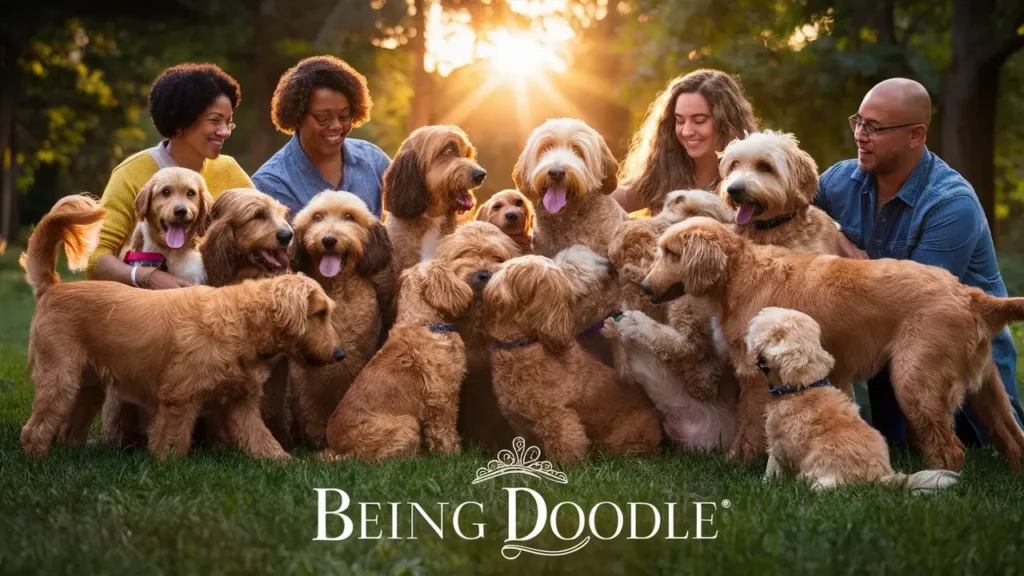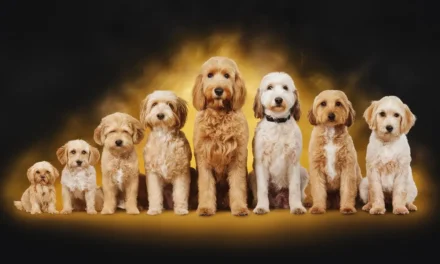
Unlocking the Golden Secret: 7 Surprising Facts About Goldendoodle Generations You Need to Know

Have you ever wondered why your neighbor’s Goldendoodle looks completely different from the one that was at the park? The answer is in the amazing world of Goldendoodle generations. It must have been an exciting trip: buckle up and join us on our fluffy adventure to becoming a Goldendoodle expert!

Being a Goldendoodle myself, I cannot tell how many times someone have asked me this kind of dog you are. which leads us to, “Well there are varieties?” Absolutely my friends, the Goldendoodle World is as diverse and detailed like their plush fur. Each generation has its own charm, be it the compact F1b or the majestic F3. But what the heck do these letters and numbers even mean, and why should you care?
We break down the complex world of Goldendoodle generations in this wagging-tale journey, crafted thread-by-thread form their genetic origins to character threads and then let loose as they roam through our homes. Seasoned Doodle enthusiast or dabbling furballnoob, our guide will teach you enough to impress your friends at the dog park. Get yourself a cup of coffee (or, you know, a doggy treat) and let us explore all the different Doodle generations!
The ABCs of Goldendoodle Generations

Let’s start with the basics. Goldendoodle generations are a bit like an encrypted key that discloses a dog’s precise genetic portfolio. Here’s a quick breakdown:
- F1: 50% Golden Retriever, 50% Poodle
- F1b: 75% Poodle, 25% Golden Retriever
- F2: Two F1 Goldendoodles bred together
- F2b: F1 Goldendoodle bred with an F1b
- F3 and beyond: Multi-generational breeding
Understanding Goldendoodle Generation Terminology: The “F” and “B”
If you are new to the world of Goldendoodles, that might not make a lot of sense. At first those letters and numbers can look like gibberish, but they are abbreviations for gene markers (or in some cases actual genes) that help paint a picture of a dog’s genetic background. So let us take at the present time to break down what those “F” along with also “B” fairly mean concerning Goldendoodle Generations.
Pro Tip: The “F” stands for “Filial,” which is just a fancy way of saying “offspring.” The number indicates how many generations removed the dog is from the original Golden Retriever-Poodle pairing.
The Letter “F”: Filial Generation
- The “F” in Goldendoodle generation names stands for “Filial,” which comes from the Latin word “filius” meaning “son” or “daughter.
- In breeding terms.Generations of offspring subsequent to crossing two purebred lines,
- The number that follows the “F” indicates how many generations removed the dog is from its purebred ancestors.
Examples:-
- F1: First-generation offspring from a Golden Retriever and a Poodle
- F2: Second-generation offspring from two F1 Goldendoodles
- F3: Third-generation offspring from two F2 Goldendoodles
The Letter “B”: Backcross
- The “B” in Goldendoodle generations names means “Backcross.”
- Definition: A backcross is when a hybrid (like an F1 Goldendoodle) gets bred back to one of the parent breeds (typically a Poodle in the case with Goldendoodles.
- This form of breeding is so important in efforts to develop a non-shedding coat and/or hypoallergenic characteristics
Examples
- F1b: An F1 Goldendoodle bred back to a purebred Poodle
- F2b: An F2 Goldendoodle bred back to a purebred Poodle or an F1b Goldendoodle
Why These Terms Matter
Terms like these can really benefit Goldendoodle owners / shopper in several ways:
- Predictability Each generation has different levels of predictability in terms of coat type, shedding, and temperament
- Hypoallergenic Potential “B” generations often have a higher chance of being hypoallergenic due to the increased Poodle genetics.
- Health considerations: F1 generations often show hybrid vigor, while later generation may have more predictable traits but potentially less vigor
- Appearance Generations may have different looks in the same litter from more Golden Retriever to most Poodle appearance
- Breeding Goals Breeders use these designations to obtain certain traits or characteristics in their breeding goals
Key Point: – Remember, every Goldendoodle is unique. Factors like individual genetics, environment, and upbringing all play crucial roles in shaping a dog’s characteristics and personality.
Size Matters: From Mini to Standard
My experience One of the most significant generators that different Goldendoodle generations from each other is the variety of sizes. As a Goldendoodle owner, I’ve seen firsthand how size can impact everything from living space requirements to exercise needs.
- Toy: Under 20 pounds
- Mini: 20-35 pounds
- Medium: 35-50 pounds
- Standard: 50+ pounds
Key Takeaways: – it is crucial to mention that the size of Goldendoodle can even depend on the generation and the size of the used Poodle parent they breeded from.
The Great Coat Debate: To Shed or Not to Shed?

The million-dollar question, after all! The primary attractions of Goldendoodles are that they have a reputation as hypoallergenic dogs. But, the hot take: Goldendoodle generations are not all equal in terms of how much they shed.
- F1: Moderate shedding
- F1b: Minimal to no shedding
- F2: Varies widely
- F2b and beyond: Generally low shedding
You can get more information about Goldendoodle Shed from our article ” Do Goldendoodle Shed “, You can also check our Goldendoodle Shed Calculator.
Pro Tip: If you’re looking for a truly hypoallergenic Goldendoodle, aim for an F1b or later generation with a curlier coat.
Personality Parade: Nature vs. Nurture
Truth be told, these pups are bred more for their dorky personality rather than any sort of physical trait. I can confirm this being a F2 Goldendoodle dadcad myself! Sure, styles may change based on the individual themselves but here’s a general rule of thumb for what you might look forward to across generations.
- F1: Balanced mix of Golden Retriever friendliness and Poodle intelligence
- F1b: More Poodle-like, often quieter and more reserved
- F2 and beyond: A delightful grab bag of traits from both breeds
Key Takeaways :- genetics cannot be denied, but these are factors beyond your control whereas training and socialization can greatly affect the behavior of a Goldendoodle.
Health Matters: The Hybrid Vigor Debate
One of the most appealing features of any mixed breed, including Goldendoodles, is hybrid vigor – the belief that crossbreeds are healthier than purebreds. However, that is not always the case.
- F1: Often exhibit strong hybrid vigor
- F1b: Still benefit from hybrid vigor, but to a lesser extent
- F2 and beyond: Hybrid vigor may decrease, but careful breeding can maintain health benefits
Pro Tips : in all generations, purchase puppies from a reputed breeder, who has the puppies all health vaccine and health screening certificates and how they have been raised, their surroundings, and cage under which they were grown.
The Price Tag: Investment in Furry Joy
let’s get down to brass tacks, or should I say, puppy chow? The price of a Goldendoodle largely depends on generation SN, as less common breeds can be more expensive to breed. Below you can see the average price ranges of each Golden doodle generation
| Generation | Average Price Range |
| F1 | USD 1500 – 2500 |
| F1B | USD 2000 – 3000 |
| F2 | USD 1800 – 2200 |
| F2B , F3 – MULTI | USD 2500 – 3500 |
Remember, these are just averages. Factors like coat color, size, and breeder reputation can influence the price.
The Generation Game: Choosing Your Perfect Match

To be honest, after having puppies from different generations, I figured that there was no right match for everyone. The one and only is the one that fits your lifestyle, preferences, and expectations
- F1: Great for first-time Doodle owners, balanced traits
- F1b: Ideal for allergy sufferers, more Poodle-like appearance
- F2: Perfect for those who love surprises (in terms of coat and personality)
- F3 and beyond: For Doodle enthusiasts looking for more predictable traits
Conclusion

As we go, I hope you’re as pumped about Goldendoodle generations as I am. F1’s have the charm, F3’s have their predictably, and generations beyond bring both specific and unique to your table.
Knowing Goldendoodle generations are crucial, but it isn’t everything. The real joy of owning a Goldendoodle rests in those big brown eyes that love to see you and bring joy and adventure in the world. Your Goldendoodle experience, merely, is your personal preference. Whether you are on team F1 or an F2b fanatic, the most important thing to consider is the ideal Goldendoodle for your lifestyle. As you begin this search for your new furry friend, do so with an open and accepting heart. Eventually, regardless of the generation and the breed, the best Goldendoodle will be the one bundled next to you on your sofa, staring at you with the sweetness that says, “I love you more than any breed preference.”
Frequently Asked Questions:
Do Goldendoodle generations affect trainability?
Although all Goldendoodles are generally intelligent and trainable, F1b and later generations may have a slight edge due to the increased Poodle influence. For any era, but consistent training and optimistic reinforcement are significant
Can you breed two Goldendoodles together?
So as mentioned earlier this is the way F2 and multigen Goldendoodles are produced. Keep in mind, though, that appropriate health screenings should be conducted for breeding and only by experienced breeders.
Do different generations have different exercise needs?
In most cases, exercise requirements are better suited to the individual dog of its size rather than necessarily how many generations have been bred back. F1b and later generations with less Golden Retriever in them may be a little higher energy but are still very typical for Doodles.
Are there any health issues specific to certain Goldendoodle generations?
While Goldendoodles are generally healthy, they can inherit health issues from both parent breeds. F1 generations may have a lower risk of inherited diseases due to hybrid vigor, but all generations can potentially face issues like hip dysplasia or eye problems.





















Recent Comments